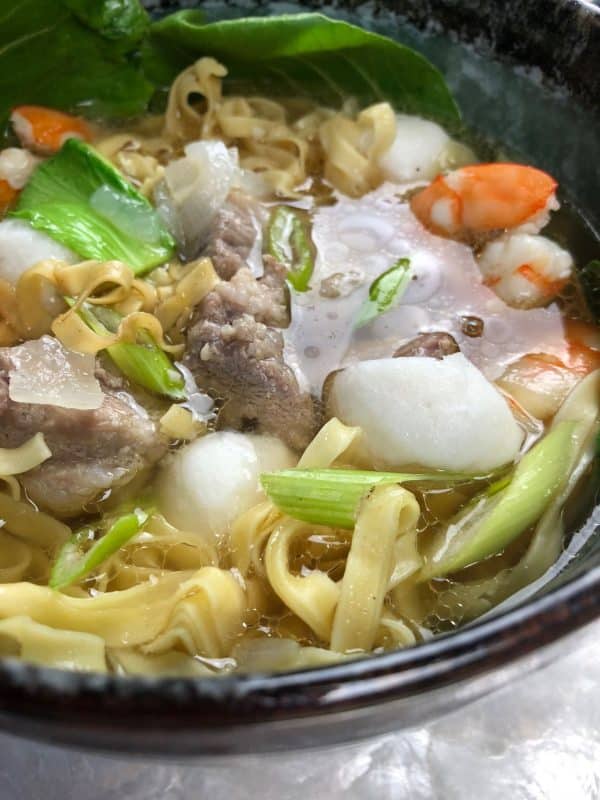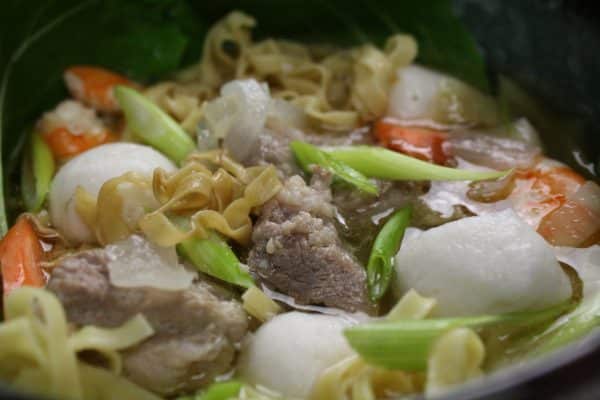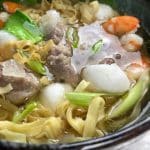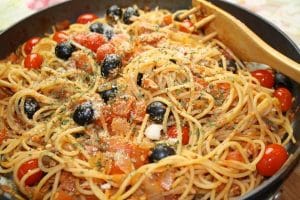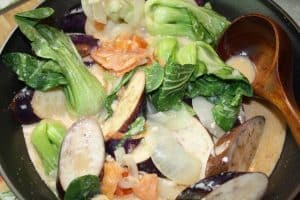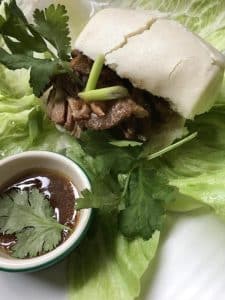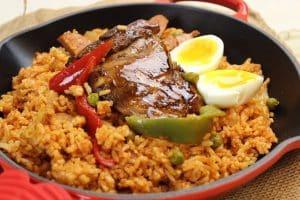Lomi Noodle Soup with Pork, Shrimps and Vegetables
As an Amazon Associate and member of other affiliate programs, I earn from qualifying purchases.
Soup soothes us. Just like this Lomi Noodle Soup with Pork and Shrimps. This is a popular Filipino soup meal. It is offered in many restaurants in the Philippines, some even specializing in just lomi noodles. This is a soup which probably originated from the Chinese dish ‘lor mee’ which has similar ingredients, according to my fellow Filipino blogger Raymond of Ang Sarap. Another explanation of the soup’s Chinese origin is the term hokkien lo mie which means a noodle dish with pork and chicken, according to Edgie Polistico, food anthropologist and author of the Philippine Food Cooking & Dining Dictionary.
That said, this Filipino meal I cooked in my American kitchen is a scrumptious soup of pork, shrimps, fish balls, thick wheat, flat noodles simmered in a clear broth and flavored with savory aromatics of garlic, onions and patis (fish sauce). It is also one of the easiest soup meals to prepare which probably explains its popularity. Start with a good soup broth. There are no hard and fast rules as to what you can toss in. You can’t go wrong with a combination of meat with the noodles and vegetables. Some recipes of lomi noodle soup have chicken, some have pork or beef. I put in pork and shrimps because it was what I had in my freezer. And I was inspired by a Lomi Soup recipe from Liza Agbanlog’s cookbook – I had interviewed her recently for a feature article on Positively Filipino online magazine.
Soup calms us because it is served piping hot, so we slow down to relish every sip. Soup soothes us because after we have calmed down, then our minds are less muddled. Soup fills up our mind, body and soul in more ways than we realize. As Christmas and the holidays rev up, take a few minutes to slow down and enjoy what the season brings. Savor some soup. It will do you good.
Lomi Noodle Soup with Pork, Shrimps and Vegetables
Ingredients
- 16 oz. fresh Chinese noodles flat or round
- 2 to 3 cups to blanch noodles boiling water
- 1/2 pound pork shoulder tenderloin sliced in thin, 2-inch strips
- 2 Tablespoons soy sauce to marinate pork
- 1/4 pound fresh shrimps large, peeled, heads and tails removed
- 2 Tablespoons calamansi or lemon juice for shrimps
- 1/2 teaspoon salt for shrimps
- 2 Tablespoons vegetable oil
- 2 pieces cloves peeled, minced garlic
- 1 whole onion medium-sized, chopped
- 1 Tablespoon patis fish sauce
- 1/2 pound fish balls frozen, about 2 cups, sliced in halves
- 8 to 10 cups chicken or vegetable soup stock
- 1 medium-sized carrot peeled, sliced
- 1 cup napa cabbage shredded
- 1 teaspoon salt
- 1 teaspoon ground black pepper
- 1 to 2 stalks scallions sliced, for garnish scallions or green onions
Instructions
- Take the fresh noodles and rinse them through cold running water to remove the sticky feeling and loosen them up.
- Put the noodles in a colander or sieve. In a small stockpot of boiling water, over high heat, quickly blanch the noodles for 30 seconds to 1 minute. Drain. Set aside.
- In a medium-sized bowl or container, add the soy sauce to the pork slices. Mix well. Cover and refrigerate for at least 1 hour for flavor to set.
- Separately, season the shrimps with calamansi and salt for 30 minutes. (Do not marinate shrimps or seafood longer than 30 minutes or they will cook in the citrus). Cover and set aside.
- In a large 10 to 12 quart stockpot, over medium-high heat, add the vegetable oil. Sauté the garlic and onions for 1 to 2 minutes till fragrant.
- Add the patis and fish balls. Blend in the pork, shrimps to the sauté. Stir around the stockpot to combine and blend the flavors. Cook for 8 minutes till pork and shrimps cook and change color.
- Pour the soup stock Stir around to mix with the ingredients. Cover and lower heat to simmer for 5 minutes.
- Add the fresh lomi noodles and vegetables. Season with salt and black pepper. Mix carefully so the noodles do not break.
- Cover and continue cooking over a medium simmer for 5 minutes more till vegetables are cooked. The noodles should have absorbed the flavors of the ingredients.
- Garnish with scallions. Serve piping hot.
- Cook's comments: The fresh Chinese noodles are thick, wheat noodles, yellow-colored and pre-boiled. They are sold in packaged plastic bags at Asian supermarkets. These boiled noodles are available in flat, round, thick or thin sizes and varieties at the grocery's freezer or refrigerated section. It is best to blanch the noodles for 30 seconds to 1 minute in boiling water before adding to the soup. The noodles expand after cooking. If dried Chinese noodles are preferred or more convenient, follow package directions on how to prepare in boiling water. For Fish Balls, you can buy them frozen from Asian markets or large supermarkets with a variety of ethnic ingredients. I make my own fish balls. You can find my homemade Fish Balls recipe in my cookbook My Mother's Philippine Recipes (Amazon.com).
- Hello, Friends! All the images and content on this blog are COPYRIGHT PROTECTED and owned by my media company Besa-Quirino LLC. This means BY LAW you are NOT allowed to copy, scrape, lift, frame, plagiarize or use my photos and recipe content I wrote, on your website,books, films, television shows or videos without my permission. If you want to republish this recipe or content on another website, video, news article,or media outlets mentioned above please ASK my permission, re-write it in your own words and simply link back to this blog to give proper attribution. It’s the legal thing to do. Thank you. Email me at [email protected]
- Disclosure: As a participant in the Amazon Affiliate program, some blog posts contain links to products used in the recipe and sold on Amazon. The price stays the same for the readers who wish to purchase these products on my links. I earn a small commission from Amazon which helps maintain the blog expenses. Thanks in advance for your support.
Nutrition
Notes on Nutrition: The nutrition information provided is an estimate and will vary based on cooking methods and specific brands of ingredients used.
Did you like this recipe? I have more classic recipes inspired by my late mother’s cooking in my popular cookbook: My Mother’s Philippine Recipes. If you’re learning how to cook Filipino food or a fan of Philippine cuisine, buy my cookbooks and books on Amazon.com sold worldwide in paperback and Kindle format.
Hello, Friends! Please DO NOT LIFT OR PLAGIARIZE my original recipe, stories, photos or videos. All the images and content on this blog are COPYRIGHT PROTECTED and owned by my media company Besa-Quirino LLC. This means BY LAW you are NOT allowed to copy, scrape, lift, frame, plagiarize or use my photos, essays, stories and recipe content on your websites, books, films, television shows, videos, without my permission. If you wish to republish this recipe or content on media outlets mentioned above, please ASK MY PERMISSION, or re-write it in your own words and link back to my blog AsianInAmericaMag.com to give proper attribution. It is the legal thing to do. Thank you. Email me at [email protected]

